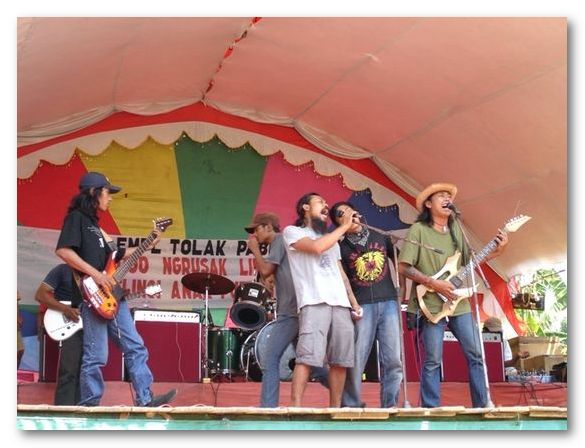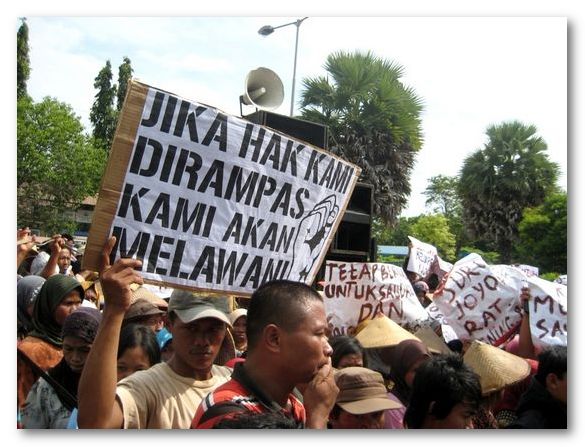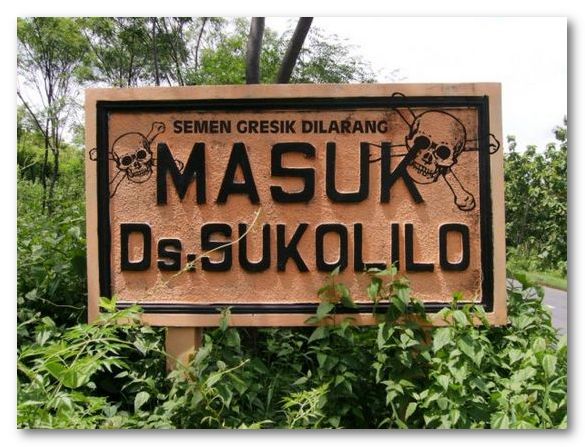Alexandra Crosby
No entry for Semen Gresik, sign at entrance to Sukolilo, 2008SuperSamin |
In mid-2005 Semen Gresik, Indonesia’s biggest cement manufacturer, released plans for a new cement factory, with a capacity of 2.5 million tons per year, in South Pati, Central Java. It seemed like a done deal. Government and corporate interests had agreed: this was the kind of development that was good for the local economy, bringing jobs and revenue.
However, no one had anticipated how strongly farmers and environmentalists would resist the plan. The factory was to exploit 1432 hectares of the land at the foot of Kendeng Mountain, mining the area’s rich limestone, which is needed for the manufacture of cement. But this location would affect eight villages (Kedumulyo, Misik, Gadudero, Sukolilo, Sumbersuko, Kasiyan, Tompegunung and Baturejo), many of which are inhabited by the notoriously strong-willed ‘Sedulur Sikep’ communities. Also known as ‘Suku Samin’ (the Samin tribe) or ‘Wong Samin’ (Samin people), Sedulur Sikep communities are famous in Java for being wise and humble fighters for environmental and social justice. In the years since the plan was announced, these farmers have instigated a widespread movement rejection the location of the cement factory on their land.
Samin farmers say ‘No’
Ojo ela elu, apik elek mungguhe awake dewe-dewe.
Don’t just go along with what you get; good or bad is up to us.
The Saminist movement is named after Samin Surontika, a villager who lived in the area of Randublatung, south of Blora, at the end of the nineteenth century. Samin preached peaceful resistance to Dutch colonialism. His tactics included ignoring Dutch land ownership laws, refusing to pay taxes to the colonial authority and confusing Dutch scouts with false or misleading information and convoluted language.
Samin communities are famous in Java for being wise and humble fighters for environmental and social justice
Samin resistance evolved in parallel with Indonesian nationalism. When Indonesia declared independence, Sedulur Sikep people opposed incorporation the new Indonesian state, refusing conditions of citizenship such as adherence to one of the five recognised religions, state education, and use of Indonesian language. Instead, they remained loyal to the self-determination of their own communities and their spiritual connection to the land, carrying on with the organic farming methods they had always used, maintaining their own education systems and their egalitarian use of only Ngoko, the low-level form of Javanese language. Samin people are famous for their proverbs, which often offer wisdom in the form of word play. Many of these, such as the proverb above, have been appropriated by environmental campaigners in recent times.
Since the surge in environmental activism that followed the end of the New Order regime in 1998, many young people have developed an interest in how Samin philosophies can be applied to contemporary struggles. Several important groups that try to merge Saminism with environmentalism emerged in Central Java, including SuperSamin in Blora, and anakseribupulau (children of a thousand islands) in Randublatung. These activists have employed new forms of resistance to complement the farmers’ struggle, using rock and punk music, zines, facebook groups, blogs, culture jamming, and online networks such as Indymedia and EngageMedia.
Significance of the Kendeng Mountain area
Activists and farmers have several concerns with the proposed cement development. These concerns are both cultural and environmental. They claim that most people living in the area of the cement factory will remain poor despite the profits the factory is projected to generate, that local water systems will be contaminated, that increased air pollution, noise and dust will reduce inhabitants’ quality of life, and that natural springs will be exhausted or fouled.
Kendeng Mountain activists aim at preserving both the region’s forests and the 87 natural springs in the proposed project area, arguing that these two goals are interconnected. Conservationists predict that 47 springs could be drained completely if the project goes ahead. They say mining limestone for cement production could severely damage the water channels in the area’s delicate karst lands which though appearing dry on the surface are in fact perforated by underground streams. They reject the claim made by the official environmental impact assessment team that the project will which would require only ‘shallow’ mining above the springs.
According to Samin farmer Gunritno, Sedulur Sikep communities reject the cement factory because of the obvious impacts it will have on the environment, which, according to Samin philosophy, must be protected as the source of human livelihood. Accompanying the possible ecological damage is the threat of the extinction of Samin culture. ‘To us, this is obvious’, he says, ‘but nobody pays us any attention. We are even considered backwards for holding such beliefs.’
Chronology of protest
 |
Randublatung-based band ‘anakseribupulau’ performs at a community gathering at Misik village, 30 October 2006anakseribupulau |
As early as 2005, before the plans were announced, farmers in Sukolilo subdistrict began to demand information about what they considered suspicious circumstances regarding land acquisition. ‘In Sukolilo in 2005 land prospectors were already swarming about’, says SuperSamin activist Koko. They claimed to be acting on behalf of an unnamed bio-energy company intending to plant castor beans for oil production. However, the farmers noticed that after the prospectors had bought two hundred hectares of land they did not plant a single seedling and gave no further explanations about their project.
Farmers and activists held the first large-scale protest on 30 October 2006, in the village of Misik, Sukolilo, where Semen Gresik had made aggressive bids for land. After a concert and speeches urging farmers to keep control of their land and criticising the lack of transparency or consultation in the government’s development plans for the area, activists organised a convoy to the city of Pati. Protestors rode five trucks and 500 motorbikes, carrying banners and distributing stickers, flyers and posters to residents. Later, in December, a sedekah bumi (thanksgiving by farmers after harvest) ceremony was held at nearby Sentul spring to give thanks for the flow of water, and point out the potential threat of development to such natural systems.
Land prospectors claimed to be acting on behalf of an unnamed bio-energy company intending to plant castor beans for oil production, but farmers noticed that they did not plant a single seedling
Momentum for the campaign built steadily over the next two years. By March 2008, residents opened environmental action headquarters at Kedumulyo, Sukolilo. The headquarters made it possible to consolidate action among the many community groups and organisations that had emerged to support the farmers’ resistance: ATOS (Alliance of People Against Cement), JM-PPK (Network of People Who Care for Kendeng Mountain), SPP (Union of Pati Farmers), FMPL (Forum of People Who Care About the Environment), JP2L (Network of Women who Care about the Environment), Komunitas Simbar Wareh (Community at Wareh Water Source), and KOPLINK (Community Who Cares About the Environment). The NGOs Desentara and WALHI (Indonesian Environment Forum), as well as Amnesty International, also became involved in the campaign.
The headquarters became an organisational base as well as a dissemination point for information and research. Activists held outdoor public film screenings and discussions there. Travelling sessions reached surrounding villages to raise concerns about the negative effects of the factory. Sedulur Sikep communities became increasingly involved, particularly in cultural and educational events about Kendeng Mountain’s unique environment.
When Semen Gresik finally released its plans for the cement factory to the public in April 2008, and offered to buy up locals’ land at only Rp. 7000–13,500 (US$0.70-1.40) per square metre, the activists were ready. They erected a banner on the main road: ‘I will never sell my land. Even if the offer reaches 500 million rupiah [$US52,000], I will protect my land!’ Later, they brought 150 buffalo to a protest, which they used to yank out the concrete pylon that Semen Gresik had installed to mark the proposed factory location.
Citizens also demanded consultation with local government authorities regarding the Environmental Impact Assessment that was going to be held. They wanted to be consulted during the assessment, considering themselves to know more about the local environment and the effects development might have on it than so-called ‘independent’ outsiders. Symbolic acts of generosity made their point about threats to their livelihoods: Samin farmers brought vegetables from their harvests to meetings, as well as traditional earthenware flasks labeled with the names of the springs in the Kendeng Mountain area.
In August 2008, Samin farmer Gunritno received a legal notice from Semen Gresik demanding clarification of a statement he made to in the newspaper Kompas regarding environmental impacts of the proposed project. The notice gave Gunritno 14 days to respond, after which Semen Gresik threatened to take further legal action. Gunritno did not respond, having never been involved in a court case, and wondering why the company didn’t come and speak to him directly in the way that Samin people generally resolve disputes. The case was dropped, but it pointed to deep cultural friction beween the developers and the local community in their attitudes to conflict resolution.
Over the following year, reports emerged of intimidation at the activist headquarters. Residents complained that unknown persons from outside the village frequently arrived on motorbikes, threatening them with vulgar language and revving of engines.
 |
Protests outside Pati courthouse demanding the release of nine arrested activists, February, 2009JM-PPK (Jaringan Masyarakat-Peduli Pegunungan Kendeng) |
After numerous failed attempts by residents to meet with local government authorities regarding the continuing pressure to sell their land, on the 22 January 2009 a crowd of residents and activists closed the road to Kedumulyo, blocking access to four Semen Gresik survey cars. They demanded to be heard by the village authorities and held the surveyors hostage for ten hours, just sitting and waiting for a meeting. It was an entirely peaceful protest.
When 250 police from the mobile brigade and other units arrived to clear the path, the situation escalated to violence. ‘They screamed and swore, dragging people away from the cars. Those who still insisted on staying were kicked, hit, and stepped on, even women and children. Everyone was in a panic,’ said Koko’, who was at the protest. ‘Then people started to fight back. Children, women, men, and even elders threw rocks at the officers until they fired gunshots into the air.’ Thirteen police officers were reported wounded and three Semen Gresik cars were damaged.
On the protestors’ side, hundreds were wounded and camera equipment damaged. The main political consequence was the arrest of nine farmers, who were charged with violent destruction of property. Over the following days, weeks, and months, hundreds of people demonstrated outside Pati courthouse, demanding the release of their comrades.
The current situation
In May 2009 the Central Java provincial administration postponed the development of the cement factory until 2010, acknowledging that the land acquisition process for both the factory and exploration sites remained unresolved. However, even after years of local resistance, Central Java governor Bibit Waluyo remains hopeful of an agreement between Semen Gresik and landowners. ‘Don’t be stubborn. Don't just say no without any clear argument,’ he cajoled farmers at a press conference.
In May 2009 the Central Java provincial administration postponed the development of the cement factory until 2010, acknowledging that the land acquisition process for both the factory and exploration sites remained unresolved
On 22 June 2009, after five long months, the nine men arrested in January were freed from Pati jail after the charges against them were reduced. The next day, Samin elder, Sutarno, who had been an important figure in the struggle against the cement factory, passed away peacefully at the age of 100 years. Hundreds of activists attended his funeral and vowed to keep fighting the development in his name, for as long as it takes. Meanwhile, the governor promised journalists and developers that the cement factory would definitely go ahead. ii
Alexandra Crosby (ali@alimander.com) is an artist, writer and researcher. She is completing a PhD at the University of Technology Sydney on the visual culture of activists in Java. She recently co-edited the book Gang Re:Publik, Indonesia-Australia Creative Adventures . The author is grateful to Exi Wijaya and Koko’ for their research assistance. The Australian Research Council supported research for this article.
For more information about the case, see the video Gunung Kendeng is in Danger , by Maruli Sihombing.



